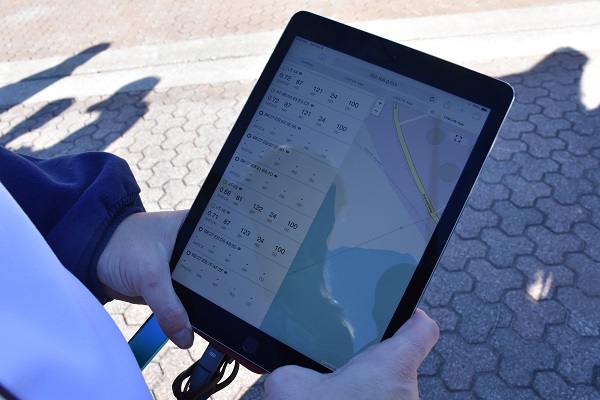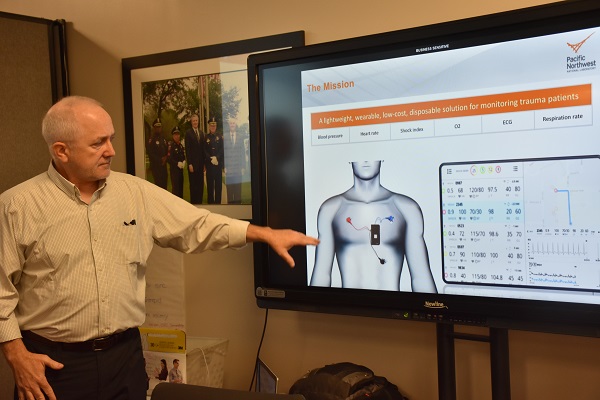
When mass casualty incidents occur — shootings, earthquakes, multiple-car pile-ups — first responders can easily be overwhelmed by the sheer number of victims. When every second counts, monitoring the vital signs of all the victims in a chaotic situation can be difficult. Emergency medical technicians and paramedics need a way to easily monitor multiple patients on scene, receive notifications when vital signs change for the worse, and share that information with everyone who needs it.
The Department of Homeland Security (DHS) Science and Technology Directorate (S&T), in partnership with the Department of Energy (DOE) Pacific Northwestern National Laboratory (PNNL), has begun to seek out these kinds of solutions over the last few years. The first solution targeting medical responders — called VitalTag — began development about 18 months ago and is now past the prototype stage.
“VitalTag Technology can be a game-changing solution to DHS and first responder operations in both mass casualty and day-to-day operations,” said D’Arcy Morgan, DHS S&T Program Manager.
VitalTag, a suite of sensors, allows data to be shared among EMTs and paramedics at a disaster site. The VitalTag suite connects to a victim’s chest, with other sensors attached to the ear and index finger. It collects then broadcasts the victim’s vital signs to the team’s mobile devices, allowing them to prioritize their attention for those in need of the most urgent care.
“Existing solutions were not designed for an extreme environment,” said Grant Tietje, Senior Project Manager at PNNL. “Responders wanted a low-cost, disposable device that could be quickly applied to those kinds of situations.”
Today’s standard tools tend to be heavy and bulky, not portable, and not all-in-one. Early on, the team at PNNL surveyed the industry and struggled to find solutions that were both light, robust and cost-efficient. An all-in-one suite could vastly improve the process of detecting vitals in a fast-paced scenario. Many of the commercial-grade tools found by PNNL even helped keep production of a single VitalTag under $100.
“It is a resource multiplier,” said Dr. Luke Gosink, Team Lead at PNNL. “Yes, ambulances have these types of equipment, but usually only a few of each. With VitalTag, many more patients can be monitored simultaneously and continuously. More situational awareness, like that achieved with VitalTag, can result in better patient outcomes.”
Another challenge was finding ways to alternatively collect data, such as blood pressure, in remote wearable fashion. Finding an affordable means of measuring blood pressure without using a cuff was difficult, but they were able to gather enough information to develop a means of doing so. To calibrate the VitalTag suite of tools, the team used its algorithms on open datasets, so the machines could learn trends for different metrics and establish a baseline.

Most of the testing up to now has been evaluation of the accuracy of vitals. A total of 25 devices have been created, 20 for DHS testing purposes and five for operational purposes. The 20 DHS devices can simulate emergency scenarios using the data collected, with different vital signs at different levels. This serves as a valuable tool for emergency medical responders, at least leading up to the release of an operational VitalTag suite.
“There was a very strong positive response from those who were able to see it in action. They asked where they could buy it,” said Gosink.
The current VitalTag prototype can monitor blood pressure, heart rate, respiration rate, blood oxygen, shock index, single-lead electrocardiogram and other metrics. These can be transmitted in real time to laptops, phones and tablets in the network. The data can be monitored from initial contact with a patient, all the way through to the patient’s recovery.
An attractive feature of the VitalTag system, which allows all of this to happen, is its multi-platform user interface, which displays all the important information in neat, comprehensive, interactive tables. Responders can use the visuals to triage patients quickly and reasonably. With the suite of VitalTag tools, information can be transmitted instantly from the disaster site, to the ambulance, to the hospital.
The benefits of VitalTag are yet to be seen in full, but if operationalized, this suite of digital tools could change the emergency medical response paradigm. VitalTag is an example of the power of data in securing the homeland, bringing different communities together for greater efficiency, and limiting the potency of threats to the public.
“Not only does it provide the opportunity to integrate data-flow in a timely and accurate manner, but it advances field medical services beyond traditional operations to a new frontier of patient care and incident triage,”said Morgan.
VitalTag was included in the Next Generation First Responder – Harris County Operational Experimentation event in early December. The efficacy of the prototype is currently being evaluated by PNNL in partnership with Anovaworks, an occupational medicine company. Evaluations will be performed to see whether measurements from VitalTag are consistent with those taken using standard medical devices.

